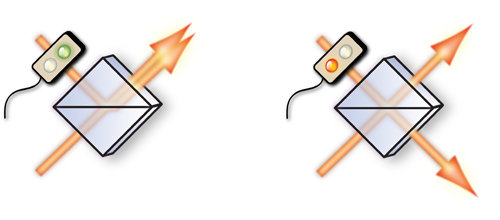Quantum-tweaking of single photons
Physicists at MPQ control quantum interference by tuning the phase of single photons.
Precise control of quantum effects is vital to the realization of entirely new technologies. For example, a computer based on quantum physical principles is expected to outperform today’s classical computers. In communication technology, quantum devices are already commercially available which allow secure transmission of data. Controlling the properties of photons down to the quantum level is at the heart of these technologies. In recent years, scientists in the group of Prof. Gerhard Rempe, Director at the Max Planck Institute of Quantum Optics (MPQ) in Garching, have managed to control the shape, frequency and polarization of single photons. However, only now have they been able to also tune the phase of single photons, as they report in Nature Photonics (Advanced Online Publication, DOI: 10.1038 /NPHOTON.2009.115, 13 July 2009). While offering new applications in quantum information technologies, these results are also of fundamental importance for understanding the quantum behavior of light.
The phase of a classical electromagnetic wave describes the state of the electric field during its oscillation cycle. It can usually be measured very precisely. However, at extremely low light intensities this is no longer true as the quantum properties of light come into play. Ultimately, Heisenberg’s uncertainty principle even prevents ascribing a phase to a single photon – but the issue has its subtleties. In their pioneering experiment, the physicists at MPQ have shown that a classical phase shift applied during the propagation of a single photon also changes the quantum properties of the photon.
Key to these new results is the reliable generation of single photons at the push of a button. For this, the team used a single rubidium atom trapped in an optical micro resonator. When the atom was repeatedly excited by appropriate laser pulses, it emitted one single photon after the other. As seen in the figure, two photons are sent onto a semi-transparent mirror (i.e. beam splitter) such that they simultaneously impinge on its two input ports.

Schematic illustration of the investigated effect. In both cases, two identical photons impinge simultaneously on a beam splitter but different phase modulations are applied (indicated by green/red light). This leads to a measureable difference in the quantum interference: both photons leave at the same or opposite outputs, respectively.
The beam splitter used in the experiments distributes the incoming light of the two inputs in equal amounts to both output ports. A classical particle would choose one of the two outputs with equal probability. Consequently, for two classical particles arriving at the beam splitter simultaneously, the probability to detect both at the same output is just as high as the probability to find them at two different output ports. At the quantum level, the situation is dramatically different: Due to their bosonic nature, identical single photons are forced to always take the same output port. This “quantum interference” effect has first been demonstrated in 1987 and is a cornerstone of modern quantum optics.
Now, the team of Prof. Rempe has built on this quantum interference and in their recent experiment they showed that it can be controlled and even inverted by tweaking the phase of one of the photons. After the detection of the first photon, a user-selected phase shift can be used to deliberately determine the path of the second photon. A subclass of the measurements revealed the possibility to guide the photons to two different output ports – a behavior that is usually attributed to fermions.
These measurements show that with regard to a complete characterization of a photon, the phase must also be taken into account. Combined with previously demonstrated control of a photon’s amplitude, frequency and polarization, the fully deterministic phase shaping presented here allows for the complete control of single photon wave packets. These results are a further step on the way to realize quantum computers on the basis of atoms and photons, and could also be used for establishing new quantum communication protocols. [OM/JB]
Contact:
Prof. Dr. Gerhard Rempe
Max Planck Institute of Quantum Optics
Hans-Kopfermann-Straße 1, 85748 Garching
Phone: +49 (0)89 32 905 -701 / Fax: -311
E-mail: gerhard.rempe@mpq.mpg.de
Dr. Olivia Meyer-Streng
Press & Public Relations
Max Planck Institute of Quantum Optics
Phone: +49 (0)89 32 905 -213
E-mail: olivia.meyer-streng@mpq.mpg.de
